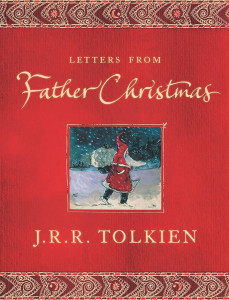 Every Christmas between the years 1920 and 1943, the ever-so-blessed children of J.R.R. Tolkien received some of the most unique mail that a child could ever hope for: letters from Father Christmas himself! Beautifully illustrated and delivered in various ways, they told of all kinds of things that happened at the North Pole, and about the folk who lived there with Santa. There is the accident-prone and sleepy North Polar Bear and his two cousins who cause havoc, the evil goblins, and of course the elves and gnomes, not to mention snowfolk and cave bears. The letters came, or so it is claimed by those who don’t believe in Father Christmas, from the Tolkien children’s father, J.R.R. Tolkien himself.
Every Christmas between the years 1920 and 1943, the ever-so-blessed children of J.R.R. Tolkien received some of the most unique mail that a child could ever hope for: letters from Father Christmas himself! Beautifully illustrated and delivered in various ways, they told of all kinds of things that happened at the North Pole, and about the folk who lived there with Santa. There is the accident-prone and sleepy North Polar Bear and his two cousins who cause havoc, the evil goblins, and of course the elves and gnomes, not to mention snowfolk and cave bears. The letters came, or so it is claimed by those who don’t believe in Father Christmas, from the Tolkien children’s father, J.R.R. Tolkien himself.
In the published collection of these charming letters, we can read how the North Pole came to be snapped in half, why Santa had to move house, what a polar bear’s writing looks like (blocky is the best description) and how Santa had to defend his home from goblins. While this book does not directly connect to Tolkien’s Middle Earth mythos, it is easy for anyone versed in that mythos to recognize the origin of some of its characters in these letters. The goblin attack on Santa’s cellar will become the Goblin-Elf wars in The Lord of the Rings, and Santa’s elf-secretary Ilbereth is the obvious progenitor of the ancient elf-queen Elbereth. We even get a fully developed look at elvish writing and the goblin alphabet!
 I’ll return to the book that is Letters From Father Christmas, but let me turn now to a reading of the Letters that I recently attended. In my opinion, the Letters truly don’t come to life for modern-day readers unless they are treated to an oral performance of them by accomplished actors. Surely the Tolkien children had the Letters read aloud to them when they received them as ‘mail’ from Father Christmas. The reading I attended took place in the front area of Longfellow Books, a wonderful independent store in downtown Portland, Maine. Kirsten Cappy, publicity manager for Longfellow, gave this introduction before the reading:
I’ll return to the book that is Letters From Father Christmas, but let me turn now to a reading of the Letters that I recently attended. In my opinion, the Letters truly don’t come to life for modern-day readers unless they are treated to an oral performance of them by accomplished actors. Surely the Tolkien children had the Letters read aloud to them when they received them as ‘mail’ from Father Christmas. The reading I attended took place in the front area of Longfellow Books, a wonderful independent store in downtown Portland, Maine. Kirsten Cappy, publicity manager for Longfellow, gave this introduction before the reading:
On September 3rd, 1973, my father sat at the breakfast table with a bowed head and proclaimed, “Children (he never called us that), today, a god passed from this world.” Now this was a confusing statement from an ardent atheist who declared even our brief foray into the Unitarian church to have been ‘too constricting’. ‘God’ was placed in the same category as ‘Santa Claus’ in our family. Both were classified as something ‘other children believed in and that we could believe in if we felt so inclined.
The ‘god’ my father spoke of was J.R.R. Tolkien, who had passed away the previous day. My brother and I managed to breathe out the question of ‘who?’ before we were waved away and my father dug mournfully into his cornflakes. Our question was answered that night at bedtime when my father opened his battered copy of The Hobbit and began to read.
The three of us read through The Hobbit and each volume of The Lord of the Rings over a year’s worth of bedtimes. Tolkien’s stories are still synonymous with the bedroom I had at that age and the gaping closet that surely housed Orcs.
I have gone on to like fiction of all sorts, but nothing has matched the intensity and obsession that Tolkien brought to his creation of Middle Earth. His professional, scholarly fascination with the dead and evolved languages of England led him to read Norse myth. He then began to create myths of his own and to create languages to feed the mouths of his myth-makers.
Lying in my bed at night I often pictured Tolkien writing, but I never pictured my father’s god with children. He had, in fact, three children and took the time from his research and his conquest of Middle Earth to play the role of Father Christmas each year. Each year for 23 years there would be a letter on the mantle piece from Father Christmas addressed to the Tolkien children. The letters spoke of each year’s chaotic preparation for Christmas, about Father Christmas’ helpers and about the mishaps that would cause some of the promised gifts to never arrive. The Tolkien children would also address letters to the North Pole. The letters were full of Christmas wishes and curious questions about life at the North Pole and about Father Christmas’ companions, Polar Bear and Ilbereth The Elf. Answers would come from Father Christmas and his helpers with lavish descriptions and detailed drawings.
With us tonight are our favorite Portland actors, Moira Driscoll, Mark Honan and Daniel Noel who comprise The Usual Suspects. The Usual Suspects give dramatic readings of modern and classic fiction bi-monthly at Longfellow Books, where they are the resident performance group. (You will note the extravagant whiskers on Daniel and Mark — they are both appearing in The Christmas Carol at Portland Stage Co.) Tonight they will be reading aloud Tolkien’s Letters from Father Christmas in the voices of Father Christmas, Polar Bear and Ilbereth The Elf. I will pass around copies of the book, so you can look at Tolkien’s sweet, obsessive drawings of the North Pole.
By the end of this introduction, the crowd of some forty folks, half adults and half children, including the offspring of several of the performers, had settled in their seats with cookies and hot drinks in hand. Now it was time for the reading…
Two of the actors, Mark Honan and Daniel Noel, were members of the cast of the recent run of A Christmas Carol at the Portland Stage Company, which was staged at Portland Performing Arts Center. Mark Honan, (Cratchit in A Christmas Carol), who played Father Christmas, is a native of England; Daniel Noel (Marley’s Ghost and several other roles, including the Narrator) was the North Polar Bear — fitting given his charming bear-like nature; and Moira Driscoll played the supercilious elf Ilbereth. They sat side by side with their copies of Letters From Father Christmas in hand — I have the copy Daniel read from complete with his post-it notes! — looking absolutely tinkly. And each read the letters as if they were Father Christmas, the North Polar Bear, or Ilbereth. I truly believed that these were letters from Father Christmas to the Tolkien children (keep in mind that this Father Christmas is not by any means a Christian-based being, but rather a sort of friendly teller of tales about what happens during the course of the year at the North Pole).
And oh, what adventures they told on that cold night! They did not read all the Letters — for that pleasure, you’ll need to pick up a copy of the cassette-only release of Sir Derek Jacobi reading the entire run. But they read for about forty-five minutes, the right amount of time on a cold winter’s night, and their selections gave the enthralled listeners a delightful time indeed. Tolkien’s language in these letters is clearer and more playful than in The Lord of The Rings. Just read these lines, which Daniel performed with a gruff voice and a glimmer in his eye: ‘Polar Bear was allowed to decorate a big tree in the garden, all by himself and a ladder. Suddenly are heard terrible growly squealy noises. We rushed out to find Polar Bear hanging on the tree himself! ‘You are not a decoration,’ said Father Christmas. ‘Anyway, I am alight,’ he shouted. He was. We threw a bucket of water on him. Which spoilt a lot of the decorations, but saved his fur.’
If Tolkien intended The Lord of The Rings to be a ‘mythology for England,’ it’s clear to me that these Letters were a personal mythology for him and his children. No matter that there are reflections of his darker work here — this reading shows beyond any doubt that the Letters were a refuge from the stark realities of being a relatively poorly compensated academic. Even if the children didn’t always get Christmas presents, they did get a letter from Father Christmas.
I turn my attention back to the new edition of Letters From Father Christmas, which was the basis of this performance. This is the first time that all of the letters have been published. What you get are facsimiles of the letters in all their glorious messiness along with a printed version on the facing page in what appears to be a Palatino font so that you can actually read them. This is important, as the handwriting of Father Christmas (roundish like ink dripping from a fountain pen on its last legs), North Polar Bear (chunky — he has big paws), and Ilbereth (best described as spidery) is less than readable. And the Letters are most definitely worth reading, as they do form an ongoing story that Tolkien very obviously relished telling in the same manner that he first told The Hobbit to his children: as an unfolding narrative over a period of time. It’s worth your time to see how much effort he put into the Letters — handwritings, drawings, quirky borders — all are here. What his children made of them is not known, nor I suppose does it matter now that they belong to all who read them, but I would have preferred Baillie Tolkien, daughter-in-law of J.R.R., to have given us just a bit more context. I even checked The Letters of J.R.R Tolkien to see if there was anything there about these letters, but not according to the index.
My recommendation is that you read these aloud to anyone who will listen, as hearing them does enhance their charm. Barring that, turn the lights down low, sink deep into that overstuffed chair by the fireplace, drink your cocoa, and listen to the cold winter’s wind howl outside as you read. Listen… Is that the North Polar Bear making his way across the roof? Or is it the Goblins attacking again?
[Cat Eldridge]
(Houghton Mifflin, 1999)
